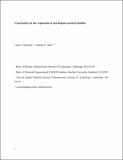| dc.contributor.author | McClune, Conor James | |
| dc.contributor.author | Laub, Michael T. | |
| dc.date.accessioned | 2021-08-05T21:02:40Z | |
| dc.date.available | 2021-08-05T21:02:40Z | |
| dc.date.issued | 2020-05 | |
| dc.identifier.issn | 0960-9822 | |
| dc.identifier.uri | https://hdl.handle.net/1721.1/131144 | |
| dc.description.abstract | Duplication and divergence is a major mechanism by which new proteins and functions emerge in biology. Consequently, most organisms, in all domains of life, have genomes that encode large paralogous families of proteins. For recently duplicated pathways to acquire different, independent functions, the two paralogs must acquire mutations that effectively insulate them from one another. For instance, paralogous signaling proteins must acquire mutations that endow them with different interaction specificities such that they can participate in different signaling pathways without disruptive cross-talk. Although duplicated genes undoubtedly shape each other's evolution as they diverge and attain new functions, it is less clear how other paralogs impact or constrain gene duplication. Does the establishment of a new pathway by duplication and divergence require the system-wide optimization of all paralogs? The answer has profound implications for molecular evolution and our ability to engineer biological systems. Here, we discuss models, experiments, and approaches for tackling this question, and for understanding how new proteins and pathways are born. Gene duplication is a common evolutionary route to subdivide functions are create entirely news ones. McClune and Laub consider the constraints placed on paralogs that function in cell signaling pathways, in particular the possibility that new paralogs could interfere with existing signaling pathways. | en_US |
| dc.description.sponsorship | Office of Naval Research (Grant N000141310074) | en_US |
| dc.language.iso | en | |
| dc.publisher | Elsevier BV | en_US |
| dc.relation.isversionof | http://dx.doi.org/10.1016/j.cub.2020.02.075 | en_US |
| dc.rights | Creative Commons Attribution-NonCommercial-NoDerivs License | en_US |
| dc.rights.uri | http://creativecommons.org/licenses/by-nc-nd/4.0/ | en_US |
| dc.source | Prof. Laub | en_US |
| dc.title | Constraints on the expansion of paralogous protein families | en_US |
| dc.type | Article | en_US |
| dc.identifier.citation | McClune, Conor J. and Michael T. Laub. "Constraints on the expansion of paralogous protein families." Current Biology 30, 10 (May 2020): R460-R464. © 2020 Elsevier Inc | en_US |
| dc.contributor.department | Massachusetts Institute of Technology. Department of Biology | en_US |
| dc.relation.journal | Current Biology | en_US |
| dc.eprint.version | Author's final manuscript | en_US |
| dc.type.uri | http://purl.org/eprint/type/JournalArticle | en_US |
| eprint.status | http://purl.org/eprint/status/PeerReviewed | en_US |
| dc.date.updated | 2021-08-05T17:52:48Z | |
| dspace.orderedauthors | McClune, CJ; Laub, MT | en_US |
| dspace.date.submission | 2021-08-05T17:52:49Z | |
| mit.journal.volume | 30 | en_US |
| mit.journal.issue | 10 | en_US |
| mit.license | PUBLISHER_CC | |
| mit.metadata.status | Complete | |
